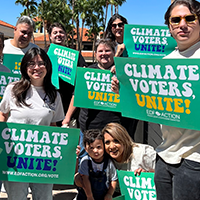New Poll: Floridians Strongly Support Infrastructure Investments in American Jobs Plan to Build Resilience, Lower Costs of Climate-Driven Extreme Weather Events
Contact:
(Washington, D.C. – June 8, 2021) As the Atlantic hurricane season kicks off this month, a new poll finds a majority of Floridians support funding natural infrastructure investments as part of the American Jobs Plan to build resilience and lower the loss of life and high financial cost of recovering from hurricanes made more destructive by climate change.
EDF Action, the advocacy partner of the Environmental Defense Fund, commissioned Morning Consult to conduct the survey. The poll gauges the opinions of Floridians on hurricanes and flooding, their costs and the solutions federal and state governments can implement to help mitigate the devastating impact of disasters and build long-term resilience. The following are major findings from the Morning Consult survey.
Key Findings:
- 89% of respondents support preventive measures to reduce the impact of natural disasters before they occur, this includes 97% of Democrats, 83% of independents and 79% of Republicans along with 85% of suburban respondents and 84% of rural respondents.
- Three quarters of respondents support funding natural infrastructure as part of the American Jobs Plan, with 66% of independents and 53% of Republicans in favor as well as 75% of coastal respondents and 76% of inland respondents.
- 86% of respondents support natural infrastructure solutions to reduce flood risk, such as restored beaches, wetlands and marshes, including 82% of independents, 81% of Republicans, 87% of coastal respondents and 88% of inland respondents.
- A majority of respondents view hurricanes and flooding as a problem in the U.S. with 80% (hurricane) and 78% (flooding) of respondents saying the costs of clean up and recovery has increased.
Explore the polling memo here.
“People right here in Florida are seeing and feeling the impacts of climate change through natural disasters like hurricanes and flooding, and are also starting to understand the cost of inaction,” said Dawn Shirreffs, Florida director. “With hurricane season here, this poll shows that residents support efforts to create a more resilient country by making investments in natural infrastructure and taking action before disaster strikes. That’s why Congress and the Biden Administration should not just fund the clean-up and recovery after each storm, but make the necessary investments in solutions like natural infrastructure as part of the American Jobs Plan. We can tackle climate change, invest in solutions that build resilience for all communities and create good-paying jobs in the process.”
Background:
Coastal communities are still reeling from the onslaught of hurricanes during last year’s record-breaking 2020 season, while experts predict another active season this year. 2020 was the most active hurricane season ever recorded. Many places, such as Louisiana that was hit by five storms including two major hurricanes, are still recovering. Through rising sea levels and warmer air and water, climate change is making hurricanes more powerful and dangerous.
Leaders at the state and federal government can act now to make investments that protect people, infrastructure and ecosystems from hurricanes and flooding, every $1 spent on disaster mitigation saves $6 in disaster recovery. One key solution should include fortifying our coastal natural infrastructure — such as barrier islands and wetlands — to serve as a first line of defense against storms and sea level rise. A study from the University of California San Diego (UCSD) found that a square kilometer of wetlands is worth approximately $1.8 million a year on average in storm protection.
Extreme weather events are getting more destructive and costly because of human-caused climate change, according to an EDF report commissioned last year by Datu Research that tabulates U.S. government statistics on the subject. Average annual costs of extreme weather have quadrupled since the 1980s, for a total of $1.75 trillion, with taxpayers footing much of the cost. The tangible costs of severe weather events are falling directly on American families. And they’re falling disproportionately on people of color – for example, one year after Hurricane Harvey’s $130 billion devastation, 27% of Hispanics and 20% Blacks in Texas still had homes that were unsafe to live in, compared with 11% of whites.
###



